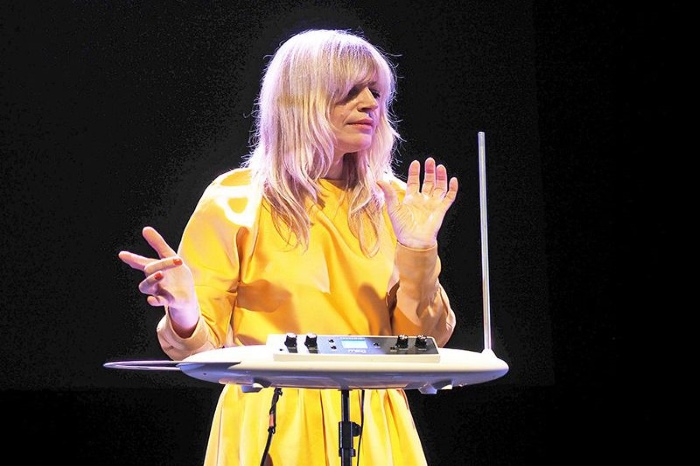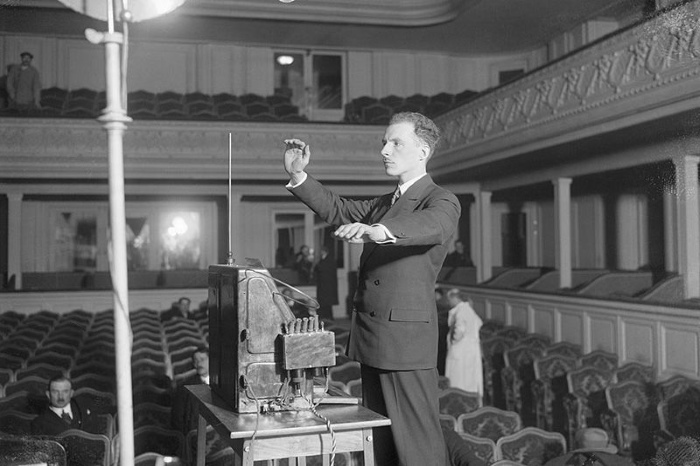Now, the theremin—a strange little invention that translates hand gestures into pitch and volume—could make a comeback

The “Play It Loud” exhibition at the Metropolitan Museum of Art spotlights the star instruments that made music electronic, from Muddy Waters’ blues axe to a shard of the psychedelic guitar that Jimi Hendrix set aflame at Monterey. Keith Emerson’s Mellotron keyboard still has a knife driven into its keys.
Tucked in the back is a small boxy item that doesn’t look like an instrument at all, but it was the one that came first. The theremin is the granddaddy that kicked off the past century of electronic music. Invented by Russian musician and scientist Lev Theremin, it bears his name.
The theremin has no strings or even moving parts. It doesn’t rely on a player’s breath. But it translates her hand gestures and motion in the air into pitch and volume, using the principle of heterodyning. In the rock era, the theremin’s unique and often eerie sounds excited legends including Brian Wilson and Jimmy Page. It was one of the good vibes in the Beach Boys’ “Good Vibrations” and was featured in some of Page’s out-there solos with Led Zeppelin.
“It was the first successful electronic instrument,” says Jayson Dobney, a musical instruments curator at the museum. The theremin in the exhibit, a Sonic Wave built in New York, belongs to Jimmy Page, who played it in “Dazed and Confused” and “Whole Lotta Love.” According to Dobney, Page “got so excited, he demonstrated it,” when the Met asked to display the instrument.
“Lev Theremin influences everybody including Moog,” adds Dobney. Robert Moog, that is, the electronic music pioneer. As a 14-year-old, Moog built his own theremin from drawings he found in a hobbyist magazine.
“Theremin has touched the lives of countless musicians and scientists,” Moog wrote in a foreword to Theremin’s biography, “and his work is a vital cornerstone of our contemporary music technology.”
On the cusp of its centennial, the weird boxy instrument is enjoying another revival. Hollywood paid tribute in First Man, where the theremin plays a central role in the score (Neil Armstrong was a fan of the instrument).
In the Beginning Was the Sound
Dorit Chrysler first encountered the theremin in New York in the 1980s. A native of Austria, Chrysler had absorbed classical music training and then rebelled against it by founding a punk band. She was visiting an artist friend in New York. “He pointed me towards his living room, where this unassuming wooden box stood in a corner,” she says. When he started playing it, “suddenly this odd, unique sound that I’ve never heard before seemed to come out from this box and responded to however he moved his hands, waving in the air.”
“I call it now the Houdini effect,” she says of seeing the theremin played for the first time. “Because it seems to defy the laws of physics.” Chrysler was inspired to take up the theremin, both as a performer with leading classical orchestras and as a composer.

Like so many inventions, it was an accident. Theremin was a radio engineer with the Soviet military in 1918 when, while building a powerful transmitter-receiver, he noticed odd feedback sounds coming from it. He said in a 1995 interview, “it turned out that when the capacity changes at a distance of the moving hand, the pitch of the sound also changes.”
He had happened on heterodyning, a process that combines two frequencies to shift one frequency range into another, new frequency. It makes for a change in pitch and volume.
Other radio engineers in Europe at the close of World War I had noticed the same effect but Theremin was the first to play with that feedback or heterodyning effect in a musical way. The new sound pleased the inventor. Fully committed to Soviet nationalism, Dobney says, Theremin “tried to find a musical sound that was modern, forward looking.”
In 1919, he built a prototype of what would become the theremin. The instrument made its first public appearance in 1920.